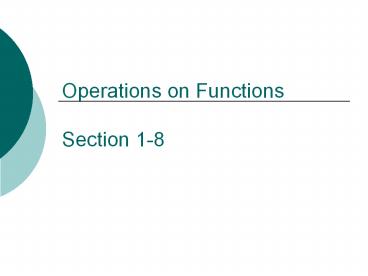Operations on Functions Section 1-8 - PowerPoint PPT Presentation
1 / 21
Title:
Operations on Functions Section 1-8
Description:
Operations on Functions Section 1-8 Objectives I can add, subtract, multiply, and divide functions I can find the domains of newly formed functions Chapter 1 Section ... – PowerPoint PPT presentation
Number of Views:253
Avg rating:3.0/5.0
Title: Operations on Functions Section 1-8
1
Operations on FunctionsSection 1-8
2
Objectives
- I can add, subtract, multiply, and divide
functions - I can find the domains of newly formed functions
3
Chapter 1 Section 8 Arithmetic of Functions
- NOTATION
f(x) g(x) means
Add the f(x) function to the g(x) function.
4
Chapter 1 Section 8 Arithmetic of Functions
- NOTATION
f(x) - g(x) means
Subtract the g(x) function from the f(x) function.
5
Chapter 1 Section 8 Arithmetic of Functions
- NOTATION
(fg)(x) means
f(x) g(x)
Multiply f(x) times g(x)
6
Chapter 1 Section 8 Arithmetic of Functions
- NOTATION
(f/g)(x) means
f(x) g(x)
Divide f(x) by g(x)
7
Let f(x) 3x 4 g(x) 2x 3
- find
- f(x) g(x)
- f(x) g(x)
- f(x)g(x)
- d) f(x)/g(x)
5x 1
x 7
6x2 x - 12
8
Operations on Functions Addition (f g)(x)
f(x) g(x) Example If f(x) 3x 6 and g(x)
-3x2 3x 4 then (f g)(x) 3x 6 -3x2
3x 4 -3x2 6x 2 Subtraction (f g)(x)
f(x) g(x) Example Use the same functions as
above. Then (f - g)(x) 3x 6 (-3x2 3x
4 ) (f g)(x) 3x2 - 10
9
Operations on Functions Multiplication (fg)(x)
f(x)g(x) Example If f(x) 3x 6 and g(x)
-3x2 3x 4 then (fg)(x) (3x 6)(-3x2 3x
4) -9x3 9x2 12x 18x2 18x 24 -9x3
27x2 6x - 24 Division (f/g)(x)
f(x)/g(x) Example Use the same functions as
above. Then (f/g)(x) (3x 6)/(-3x2 3x 4)
except for x values that make denominator 0
10
Finding the domains of our new functions
- Finding the domains of these new functions is a
little complicated. - The first step is to find the domain of each
function. - The second step is to find the intersection of
the domains. This intersection is the domain of
the new function. - Unless the operation is division in which case
you must also exclude x-values that make the
denominator zero
11
(No Transcript)
12
Lets do an example Let a) Find (f g)(x) and b)
its domain. (f g)(x)
Step 1 The domain of f(x) is -2,?). The
domain of g(x) is 0,?). Step 2 -2,?) ? 0,?)
0,?). Since this is not a quotient I
dont have to worry about division by zero.
13
(No Transcript)
14
Lets do an example Let a) Find (f - g)(x) and b)
its domain. (f - g)(x)
Step 1 The domain of f(x) is (- ?,?). The
domain of g(x) is (- ?,?). Step 2 (- ?,?) ? (-
?,?) (- ?,?). Since this is not a quotient
I dont have to worry about division by zero.
15
(No Transcript)
16
Example Let a) Find (f g)(x) and b) its
domain. (f g)(x)
Step 1 The domain of f(x) is (- ?,?). The
domain of g(x) is (- ?,?). Step 2 (- ?,?) ? (-
?,?) (- ?,?). Since this is not a quotient
I dont have to worry about division by zero.
17
(No Transcript)
18
Another example
- Find (f /g)(x) and b) its domain.
Step 1 Domain of f(x) is 0,?). Domain of
g(x) is 10, ?) Step 2 0,?) ? 10, ?)
10, ?) Division so we cant plug in
10 so Domain is (10, ?).
19
Example
- Given f(x) x 5 and g(x) x2 -1, find
(fg)(x), (f - g)(x), (fg)(x) and (f/g)(x) - (fg)(x) f(x) g(x) (x 5)(x2 1)
- x2 x - 6
- Domain (fg)(x) (- ?, ?)
- (f g)(x) f(x) g(x) (x 5) (x2 1 )
- x 5 x2 1
- -x2 x 4
- Domain (f g)(x) (- ?, ?)
20
Example
- Given f(x) x 5 and g(x) x2 -1, find (f -
g)(x), (fg)(x) and (f/g)(x) - (fg)(x) f(x)g(x) (x 5)(x2 1)
- x3 x 5x2 5
- x3 5x2 x 5
- Domain (fg)(x) (- ?, ?)
- (f/g)(x)f(x)/g(x) (x 5)/(x2 1)
- Domain (f/g)(x) All real except x? 1 or 1
- (- ?, -1) U (-1,1) U (1, ?)
21
Homework
- WS 2-1































